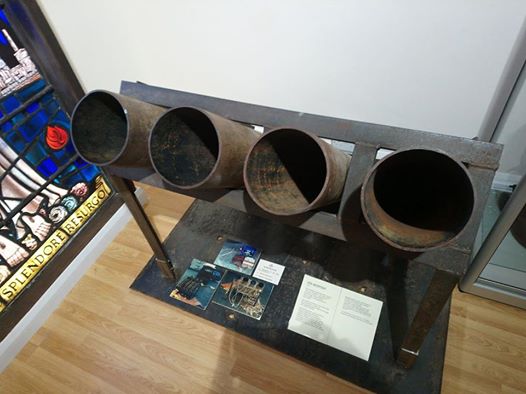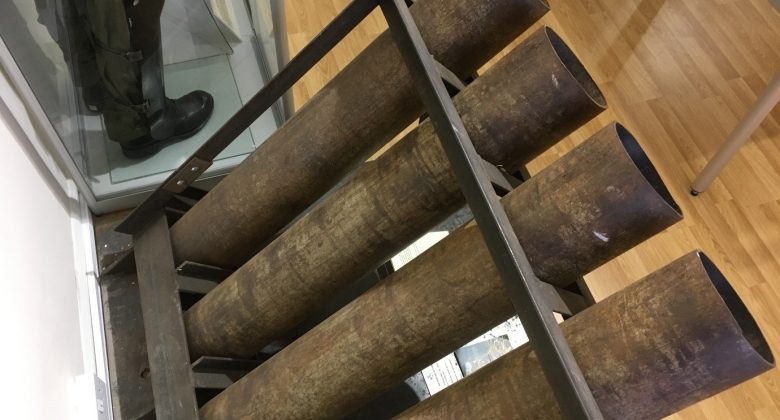The PIRA Mark.10 Mortar
By Paul Rundle
On the 20th January 1990, the joint Royal Ulster Constabulary/British Army Security Base at Newtownhamilton, a border market town in South Armagh, Northern Ireland, came under fire from a PIRA Mk. 10 multi-barrelled mortar (the designation given by the British Army for this weapon). The four tubes were fired from the rear of a Toyota van; only one of the bombs landed inside the base and luckily it failed to explode. The mortar on display in the museum (and pictured) is the actual weapon used and was seized by the 2nd Battalion Light Infantry (2 LI) after the attack.
Mortars of this type were regularly used by the PIRA (Provisional IRA) against security bases in Northern Ireland. Mortars allowed explosives to be projected into high security areas where it would have been impossible to plant explosives without being detected. The Mark 10 mortar could be relatively easily mass-produced from cut down oxyacetylene cylinders fitted on a steel frame. The bombs were made from CO2 gas cylinders commonly found in pubs, and were fired in salvoes of up to 40, although four to eight was more usual. The weapon was fired on a delayed fuse which enabled the operator to make good his escape and normally an explosive charge was triggered after firing to destroy the mortar and delivery vehicle thus preventing forensic analysis.

In the late 1980’s the Prime Minister Margaret Thatcher was top of the PIRA’s list for assassination following the failed attempt on her life in the Brighton Hotel bombing. In mid-1990 two IRA members travelled to London to plan a mortar attack on Downing Street. One of the PIRA members was knowledgeable about the trajectory of mortars and the other, from the Belfast Brigade, was familiar with their manufacture. The active service unit purchased a Ford Transit van and rented a garage. A PIRA co-ordinator procured the explosives and materials needed to manufacture the mortars. They were constructed and a hole was cut in the roof of the van for the mortars to be fired through. Whitehall was reconnoitered and a launch site was identified from where the mortars could be fired at the rear of 10 Downing Street. Once preparations were complete, the two PIRA members returned to Ireland, as the PIRA leadership considered them too valuable an asset and did not wish to risk them being arrested in any follow-up operation by the security services. In November 1990 Margaret Thatcher unexpectedly resigned from office, but PIRA decided that the planned attack should still go ahead, targeting her successor John Major.
On the morning of 7 February 1991, the War Cabinet, senior government and military officials were meeting at Downing Street to discuss the ongoing Gulf War. As the meeting began a PIRA member drove the transit van to the launch site situated at the junction of Horse Guards Avenue and Whitehall close to the headquarters of the Ministry of Defence, approximately 200 meters from Downing Street. At 10:08 am, as a policeman approached the van to investigate, the three mortar bombs were launched by timer followed by the explosion of the incendiary device which set fire to vehicle.
Each bomb was four-and-a-half feet long, weighed 140 pounds (60 kg) and carried a 40 pound (20 kg) payload of the plastic explosive Semtex. The type of device used was a Mark 10 mortar (a three-barreled version of the one on display here in the museum). Two bombs landed on a grassed area near to the Foreign and Commonwealth Office and failed to explode. The third exploded in the rear garden of 10 Downing Street, 30 meters from the office where the cabinet was meeting. Had the shell impacted on 10 Downing Street itself it is probable the entire cabinet would have been killed. On hearing the explosion the cabinet ducked under the table for cover. Bomb-proof netting on the windows of the cabinet office muffled the force of the explosion, which also scorched the rear wall of the building and made a crater several feet deep in the garden. No members of the cabinet were injured, but four people received minor injuries, including two police officers injured by flying debris.
Peter Gurney, the head of the Explosives Section of the Anti-Terrorist Branch who defused one of the unexploded bombs, gave his reaction to the attack: “It was a remarkably good aim if you consider that the bomb was fired 250 yards [across Whitehall] with no direct line of sight. […] You’ve got to park the launch vehicle in an area which is guarded by armed men and you’ve got less than a minute to do it. I was very, very surprised at how good it was. If the angle of fire had been moved about five or ten degrees, then those bombs would actually have impacted on Number Ten.”
The next PIRA mortar attack of significance in the UK occurred between 9th and 14th March 1994 when three mortar attacks were launched against Heathrow airport in five days. These mortars were fired from scrubland around the airport and from the car park of the Excelsior hotel. They had been dug in to a depth of 3-4 ft and very carefully camouflaged then fired by a timing device. A total of 12 bombs had been fired but all had failed to explode due to a persistent mechanical defect. One had landed on the roof of Terminal 4 whilst passengers were still inside.
The PIRA continued to use Mortars of various types up to the Good Friday agreement on 10th April 1998.
By Paul Rundle, LI Archivist & Research Team member
(Apologies: an earlier version of this article and the July newsletter incorrectly stated that the PIRA Mortar pictured was seized by 3LI, however it should have read Support Company 2LI.)
If you’d like to find out more about the items and weaponry on display at Bodmin Keep, or if you have a memory or story you’d like to tell us about one of our collection items, please get in touch.

